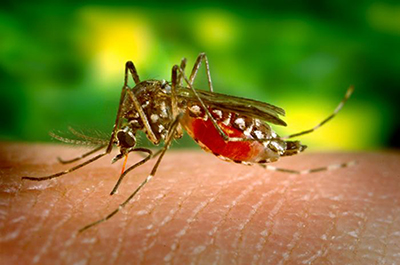 Purdue University - Extension - Forestry and Natural Resources
Purdue University - Extension - Forestry and Natural Resources
Got Nature? Blog
While researchers say it is difficult to determine whether unusual weather patterns this winter and spring will lead to larger mosquito and tick populations in the Upper Midwest this summer, one thing is certain – anyone planning to spend time outdoors should take steps to avoid the potentially dangerous pests.
“Every year we face the same risks and every year it is wise to take precautions,” said Catherine Hill, Purdue University medical entomologist. “If you’re going to be outside anytime from early spring to late summer and early fall, you need to be thinking about prevention and protection.”
Both mosquitos and ticks can carry a number of pathogens that could pose a serious threat to people and animals. Mosquitos can transmit several viruses that can cause severe encephalitis (inflammation of the brain and spinal cord), including Zika and West Nile virus, among others. Ticks are known carriers of Lyme disease, which infects about 300,000 people each year, as well as less common but equally dangerous conditions such as anaplasmosis, babesiosis, Powassan and Rocky Mountain spotted fever.
To avoid mosquito bites, the best advice is to stay indoors during peak biting times, which is typically dusk to dawn for the mosquitoes that transmit West Nile virus and during the day for mosquitoes that transmit Zika.
“If you have to be outside during those times, it is best to wear clothing that can help prevent bites,” Hill said. Appropriate wardrobe choices include long-sleeve shirts and long pants tucked into socks. It is also advisable to use an effective repellant, such as products containing a minimum of 20 to 30 percent – of diethyltoluamide, commonly known as DEET. The Centers for Disease Control also recommends products containing picardin, lemon of eucalyptus and IR3535. More information is available on the CDC website at https://wwwnc.cdc.gov/travel/yellowbook/2016/the-pre-travel-consultation/protection-against-mosquitoes-ticks-other-arthropods.
Mosquitoes breed in standing water and their larvae and pupae need water to develop. Homeowners can help reduce mosquito populations in their back yard by dumping standing water out of buckets and wading pools, keeping lawns mowed and removing piles of brush or yard waste, Hill said.
Ticks can thrive in back yards as well, particularly those adjacent heavily wooded areas, in tall grass and brush and under leaf piles.
Hill said the warmer winter and wet spring could have created ideal conditions for ticks in some areas although conditions vary significantly from region to region.
“We’ve already been getting plenty of ticks,” Hill said. “They’re certainly active.”
The best defense against ticks is to wear light colored clothing with long sleeves and pants and to use a U.S. Environmental Protection Agency-approved repellant. It is also a good idea to check your body and clothing for ticks immediately after coming back indoors.
“If you can remove a tick within 24 hours, you have a very good chance of catching them before they transmit,” Hill said.
Ticks feed on blood and tend to attach themselves to tender areas of the skin, including around the hairline and in the armpit and groin.
For the full article, see Purdue Agriculture News.
Resources:
Mosquitoes, Purdue Extension Entomology
One Small Bite: One Large Problem, Got Nature?, Purdue Extension-FNR
Darrin J Pack, Writer/Editor
Purdue University Department of Agricultural Communication
Catherine A Hill, Professor of Entomology/Vector Biology
Purdue University Department of Entomology

Recent Posts
- Report Spotted Lanternfly – Purdue Landscape Report
Posted: April 10, 2024 in Alert, Forestry, Invasive Insects, Plants, Wildlife, Woodlands - Declining Pines of the White Variety – Purdue Landscape Report
Posted: in Alert, Disease, Forestry, Plants, Wildlife, Woodlands - Are you seeing nests of our state endangered swan? – Wild Bulletin
Posted: April 9, 2024 in Alert, Forestry, How To, Wildlife - Cicadas in Spring! – Purdue Landscape Report
Posted: in Forestry, Plants, Safety, Wildlife - New Deer Impact Toolbox
Posted: April 7, 2024 in Forestry, Land Use, Plants, Publication, Safety, Wildlife, Woodlands - 2024-25 Fishing Guide now available – Wild Bulletin
Posted: April 4, 2024 in Alert, Aquaculture/Fish, Aquatic/Aquaculture Resources, How To, Ponds, Wildlife - Help Research Chronic Wasting Disease – Wild Bulletin
Posted: April 3, 2024 in Disease, Forestry, How To, Safety, Wildlife, Woodlands - Indiana Reptiles and Amphibians – IFWOA Webinar
Posted: April 1, 2024 in Forestry, How To, Webinar, Wildlife, Woodlands - Birding through the Seasons – IFWOA Webinar
Posted: in Forestry, How To, Webinar, Wildlife, Woodlands - Look Out for Invasive Carp in Your Bait Bucket – Wild Bulletin
Posted: March 31, 2024 in Alert, Aquaculture/Fish, Aquatic/Aquaculture Resources, Invasive Animal Species, Wildlife
Archives
Categories
- Alert
- Aquaculture/Fish
- Aquatic/Aquaculture Resources
- Ask the Expert
- Christmas Trees
- Community Development
- Disease
- Drought
- Forestry
- Forests and Street Trees
- Gardening
- Got Nature for Kids
- Great Lakes
- How To
- Invasive Animal Species
- Invasive Insects
- Invasive Plant Species
- Land Use
- Natural Resource Planning
- Nature of Teaching
- Plants
- Podcasts
- Ponds
- Publication
- Safety
- Timber Marketing
- Uncategorized
- Urban Forestry
- Webinar
- Wildlife
- Wood Products/Manufacturing
- Woodland Management Moment
- Woodlands
